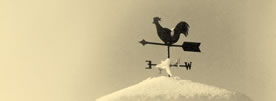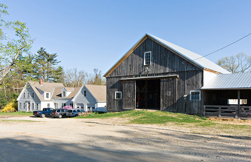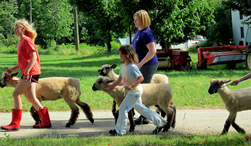Sartell Farm
Your hosts Ted and Felicia Sartell first moved to Temple in 1978 when they bought a home on Fish Road. Ted longed to return to his farming roots and in 1994 they were able to acquire this farm. They soon became part-time farmers when they started 4-H sheep projects for their children, Nate, who was 10 at the time, and Kate, who was 8. When the Sartells moved here no animals had been on the farm for several years, the pastures and fields were overgrown, fences needed to be rebuilt, and the barn and house needed significant repairs. Over the ensuing years they have worked steadily to restore the property to a working, albeit part-time, small farm.
Welcome to Our Farm
Our farm house dates from the early 1800’s and the barn most likely from the mid 1800’s. The barn is a classic post and beam structure which was originally used for dairy cows. Our land includes grazing pastures bordered with old stone walls and a meadow which allows us to grow most of our own hay for the sheep flock. A friendly guard donkey (named Connie) and a flock of hens share the farm with the sheep. We raise registered Oxford sheep which we sell to a variety of markets including as breeding stock, show animals, 4-H projects, and pets. Our primary market is direct sales of freezer lambs and meat to a growing local base of consumers who are concerned about their food supply quality and source. Our total flock size varies from around 30 in the fall to around 70 in late spring at the peak of lambing season. We have typically bred around 20 ewes with about 40 lambs being born mostly in February and March.
The Barn
The oldest part of the barn is ~40 by ~60 feet. Nothing much is exact, plumb or square in an old barn like this. It is oriented north-south on a granite block foundation. The northern ~1/4 section of the barn was added later. You can tell this from the different beam work upstairs and from the differences in the basement foundation. The addition on the barn’s east side is ~24 by 40 feet. It was added as machinery shed in the 1970’s. We have made modifications to both the barn and the shed to optimize it for our sheep operations.
When It Was a Dairy Barn
- The cows were stanchioned on the east side of the first floor, facing the main bay. Cows were a lot smaller then.
- The barn and house were connected as one structure. In the winter the farmers never had to go outside.
- The cows went down a ramp into the basement, where there was a well from which water was hand pumped for them to drink.
- The cows’ manure was dropped into the basement via openings in the plank flooring. The manure could be stored through the winter and then removed in the spring. You can still see the old “drop” in the chicken- pen floor.
- Loose hay was stored in the barn lofts; note ladders that go to the roof on either side of the main bay. The old hay track in the peak was removed but one pulley remains up on the north wall.
People Who Have Worked on this Barn
The following people did significant work for us on this barn:
- Wilfred Weston – put in west granite foundation, re-built sill, jacked up barn to help square it up and level out roof line
- Chris Weston – worked with Wilfred, made new doors and bays
- Charlie Willard – put in underground drainage
- Glenn Nutting – re-sided main barn, rebuilt some bays
- Alan Soini – restored joints with custom steel brackets, added missing beams, put new posts in basement, rebuilt roof structure and added metal roofs, built 2 wooden bulk-feed bins
Other Items of Interest


Back to the Barns List
|










